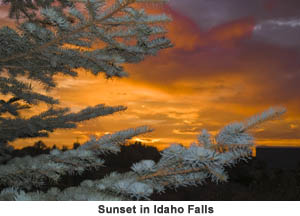Greg Nyquist |
Touring America's Northwest: Idaho
Editor's Note: This article is fourth in a series of travel sketches from America's northwest, including northern California, Nevada, Idaho, Wyoming, Montana, Washington, and Oregon. You can read the previous article in the series, on Nevada, by going here.
Although rather hot in the summer and cold in the winter, Idaho can nonetheless be described, in terms of the look of the place, as, in the main, a rather lukewarm state, neither especially beautiful nor especially ugly, but somewhere in between; pleasant, though hardly awe-inspiring. Oh, to be sure, in this corner or that, the landscape may veer off into the striking. Those mountain ranges in the middle of the state, the Sawtooth Range and what not, are rumored to have their share of the picturesque. And the Bitterroot Range along the Montana border, and further south along the Continental Divide — in such places will you find a scene or two worth gaping at. But of southern Idaho, up among the ranch lands of the Snake River Plain — not much to divert the eye in these quadrants, on a steamy summer Sunday afternoon, under a sky bleached in a thick shimmering sun-drenched haze!
As one travels through the scattered metropolises of southeastern Idaho — particularly Twin Falls and Idaho Falls — one is impressed by the utterly lack of distinction of these places. They have very little of their own that serves to uniquely identify them. Hardly a glint of individuality to be found anywhere! If you were, like Rip van Winkle, to suddenly awaken, without having idea where you were, in the midst of Twin Falls or Idaho Falls, there would be hardly anything — no landmark or indelible feature — to plainly testify to you which city you found yourself in. The Snake River, which passes through both Twin Falls and Idaho Falls,  might give you a hint — that is, if you knew it was the Snake River. Otherwise everything looks like it does in hundreds of other small cities, with its strip malls, its crowded parking lots, and its traffic choked streets. The leveling effects of globalism are felt even here, in remote Idaho. Consumer capitalism inexorably transforming all of suburban America after a single pattern. Strip malls and big box retailers and streets and parking lots overflowing with gas guzzling suburbans and jumbo pickup trucks. And all of this done in the very teeth of Peak Oil, at the very point in history when Age of Cheap Energy is about to draw to a close. How will all these zealous American shoppers, carrying, on average, $9,000 in credit card debt, manage when gas rises to four, or even five or six, dollars a gallon, as will inevitably happen in the near future? The long-term prospects for this consumerist utopia hardly looks rosy!
might give you a hint — that is, if you knew it was the Snake River. Otherwise everything looks like it does in hundreds of other small cities, with its strip malls, its crowded parking lots, and its traffic choked streets. The leveling effects of globalism are felt even here, in remote Idaho. Consumer capitalism inexorably transforming all of suburban America after a single pattern. Strip malls and big box retailers and streets and parking lots overflowing with gas guzzling suburbans and jumbo pickup trucks. And all of this done in the very teeth of Peak Oil, at the very point in history when Age of Cheap Energy is about to draw to a close. How will all these zealous American shoppers, carrying, on average, $9,000 in credit card debt, manage when gas rises to four, or even five or six, dollars a gallon, as will inevitably happen in the near future? The long-term prospects for this consumerist utopia hardly looks rosy!
As the largest metropolitan area within hailing distance of Yellowstone and the Grand Tetons, Idaho Falls has become a fairly popular stopover destination. Numerous hotels have sprung up to fill the need. At least one more springing up this very moment, and a very imposing one at that: a fourteen story Marriot hotel at Taylor's Crossing which, when completed, will be the tallest building in all of Idaho Falls. (It will not, alas, be the tallest building in Idaho. That honor goes to the twenty story U.S. Bank Plaza in Boise.)
Jackson, Wyoming, gateway to the Grand Tetons National Park, is only about a two-and-a-half hour drive from Idaho Falls. Highway 26, following the winding course of the Snake River,  will get you there without much fuss. But there is a better way. Highway 31, branching off Highway 26 then, while no one's looking, turning into Highway 22, leads you right up into the south end of the Tetons, only to bring you down right into the lap of Jackson Hole. There is no more grand way to enter Wyoming, driving through Teton Pass, where, from 8,431 feet in elevation, all of western Wyoming — the Gros Ventre Range to your right, the Wild River Range, along which courses the Continental Divide directly ahead — spreads out before you.
will get you there without much fuss. But there is a better way. Highway 31, branching off Highway 26 then, while no one's looking, turning into Highway 22, leads you right up into the south end of the Tetons, only to bring you down right into the lap of Jackson Hole. There is no more grand way to enter Wyoming, driving through Teton Pass, where, from 8,431 feet in elevation, all of western Wyoming — the Gros Ventre Range to your right, the Wild River Range, along which courses the Continental Divide directly ahead — spreads out before you.
On the Idaho side of things, before reaching Teton pass, as you ascend those winding mountain roads, you find yourself increasingly in a moist, green, picturesque locale of steep verdurous hills and babbling brooks. If you had to live in Idaho, here would be as good a place as any. The west-facing slopes produce an abundance of rain and snow — more than 128 inches of the powdery stuff every winter, if the weather maps don't lie.
If the most idyllic portions of southern Idaho are among the foothills and western facing slopes of the Tetons, northern Idaho — the state's narrow panhandle pointing towards Canada — must make do with its picturesque, though hardly spectacular, lakes. Coeur d'Alene lake, as glimpsed from Interstate 90, is hardly overwhelming, its deep blue waters lapping against yellow hills dotted with green bushes and trees. There are several other lakes — Lake Pend Oreille for one, one of the deepest lakes in the world — which cannot be espied from Interstate 90, but which are probably not very different from Coeur d'Alene.
The Coeur d'Alene area rests on a plateau of sorts which raises it above the nearby desert plains surrounding Spokane, just across the Washington border. The rise in elevation, although modest (only a few hundred feet) is just enough to engender a bit of moisture from passing storms and thus prevent this part of the state from becoming just another high desert. Interstate 90, once it traverses beyond Coeur d'Alene, quickly descends into the least attractive portion of Washington: namely, the nondescript desert environs surrounding Spokane. Of Washington, and what the cursory tourist, idly passing through its vast plains of deserts, its majestic mountains, its throbbing metropolises, finds therein, we save for another occasion rather than this one.
To read the next article in this series, about Tetons, go here.
Greg Nyquist is the webmaster for jrnyquist.com. He can be reached at machiavel@mac.com.




